Breastfeeding your baby gives him or her the best possible start in life and has many benefits for both you and your baby. This section provides information to help you get breastfeeding off to a good start, to enable you to continue breastfeeding for as long as you wish and support you throughout your feeding journey with information and local sources of support. Use the options on the left hand menu for more detailed advice.
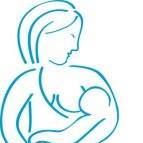
Mother to Mother support is available from trained volunteers who use their breastfeeding experience to support Mums to breastfeed their babies. Our peer support volunteers are trained to support mums experiencing simple breastfeeding problems. These sessions provide mums with the opportunity to get together in an informal environment to socialise and support each other in all aspects of feeding their babies.
Our breastfeeding support groups allow you the chance to talk to other parents and our breastfeeding peer supporters. These groups are run by our Infant Feeding Practitioners and are bookable by contacting Locala on 0300 304 5555:
Mondays 10am - 11:30am (please book 03003045555)
Almondbury Children’s Centre and Library
Off Farfield Road, Almondbury, Huddersfield
HD5 8TD
Thursday 10-11:30am (please book 03003045555)
Dewsbury Childrens centre
100 Heckmondwike Road
WF13 3NT
Tuesdays and Fridays 09.45am - 11.45am Term Time
Paddock Jubilee Centre (Breastfeeding Peer Support runs alongside Melody Makers)
Market St, Paddock, Huddersfield
HD1 4SH
If you need breastfeeding support in the evening or over the weekend please contact the National Breastfeeding Helpline - 0300 100 0212 or visit them here.
Breastfeeding Guide - the guide is on NHS Choices and provides information on the benefits of breast feeding, useful tips, and details of where you can get help and support.
Breastfeeding Support - This is a very comprehensive, easy to follow resource for common breastfeeding issues.
The Baby Friendly Initiative - This is a programme started by the World Health Organisation and UNICEF. They provide guides, research and other useful information on breastfeeding.
Kellymom.com - An excellent resource for parents about all aspects of breastfeeding your child.
NCT - This is a charity to support parents. They offer information and support in pregnancy, birth and early parenthood.
The Breastfeeding Network - They aim to be an independent source of support and information for breastfeeding women and those involved in their care.
It's never too early to start thinking about how you're going to feed your baby. Today, most women in England are choosing to breastfeed and these are some of the reasons why:
Breastfeeding is the healthiest way to feed your baby. Exclusive breastfeeding (giving your baby breast milk only) is recommended for around the first six months (26 weeks) of your baby's life. After that, giving your baby breast milk alongside other food will help them continue to grow and develop.
Breastfeeding is good for babies. Breastfed babies have:
The longer you breastfeed, the longer the protection lasts and the greater the benefits.
Infant formula doesn't give your baby the same ingredients or provide the same protection, while breast milk adapts to meet your baby's changing needs.
Breastfeeding doesn't only benefit your baby, it benefits your health too. Breastfeeding is good for mums because it:
Exclusive breastfeeding can also delay the return of your periods. For more information on contraception, see sex and contraception on NHS choices.
All mothers and babies should have the opportunity to have skin-to-skin contact straight after birth. This will keep your baby close, warm and calm, and it will steady their breathing.
This can be a bonding experience for mum and baby. It's also a great time to start your first breastfeed because your baby will be alert and keen to feed. If you need any help, your midwife will offer support with positioning and attachment.
Your baby will be happier if you keep them near you and feed them whenever they're hungry. This will remind your body to produce plenty of milk.
Skin-to-skin contact is good at any time. It will help to comfort you and your baby over the first few days and weeks as you get to know each other.
If you've already been formula feeding for a few days but you've changed your mind and want to breastfeed, speak to your midwife or health visitor as soon as possible for support on how to build up your milk supply. You can also call the National Breastfeeding Helpline on 0300 100 0212.
If you decide to formula feed, go to Making up infant formula for practical and important safety information.
If your baby is born by caesarean section, you should still be able to have skin-to-skin contact with your baby straight after the birth. Some births involve complications that mean skin-to-skin may be delayed. If this happens, it doesn't mean that you won't be able to breastfeed your baby. Your midwife will help you have skin-to-skin contact with your baby as soon as it's possible.
If your baby is in a neonatal unit in hospital after the birth, you'll probably be encouraged to try Kangaroo Care. This means that when your baby is ready, you can hold your baby against your skin regularly, usually under your clothes.
This skin-to-skin contact helps you to bond with your premature baby, and it increases your milk supply. Read more information about breastfeeding a premature baby.
Breastfeeding is a skill that needs to be learnt, and it can take time and practice to get the hang of it. There are lots of different positions for breastfeeding. You just need to check the following points.
UNICEF - Positioning and attachment (PDF)
1. Hold your baby close to you with their nose level with the nipple.
2. Wait until your baby opens their mouth really wide with the tongue down. You can encourage them to do this by gently stroking their top lip.
3. Bring your baby on to your breast.
4. Your baby will tilt their head back and come to your breast chin first. They should take a large mouthful of breast. Your nipple should go towards the roof of their mouth.
If breastfeeding feels a bit awkward at first, don't worry. You and your baby may just need a little more practice. Breastfeeding is a skill that you and your baby learn together, and it can take time to get used to. Go to Breastfeeding problems for more information and advice.
If you have any questions or concerns, you can always speak to your midwife or health visitor, or call the National Breastfeeding Helpline on 0300 100 0212.
One of the biggest challenges for new parents is getting used to the changes that a baby will bring to their night-time routine. A leaflet, designed to offer helpful, practical advice on coping at night has been produced by UNICEF. It covers getting some rest, night feeding, safe sleeping environments and helping baby to settle.
Click here for more information (Unicef Caring at Night PDF).
Sleep is one of the topics that new parents have a lot of questions about. Although we all know that the first few months with a baby will involve disrupted nights, our expectations for how long this lasts, and our understanding of how normal infant sleep develops, can be unclear or unrealistic, and comments from others can be worrying. The following website provides great resources on sleep information.
Infant Sleep Information Source website
Sudden Infant Death Syndrome (SIDS) is the sudden and unexpected death of a baby where no cause is found. While SIDS is rare, it can still happen and there are steps parents can take to help reduce the chance of this tragedy occurring. Click here for the Lullaby Trust’s leaflet for information.
Dads play an important role in supporting mothers who decide to breastfeed. Support and encouragement are a ‘must’ so that baby and mum can feel comfortable. Sometimes dads want to ask questions and don’t always feel they can or don’t wish to upset their wife/partner if they have decided they are going to breastfeed.
It’s normal to feel like a bit of a spare part at first but there are plenty of ways to get involved and play your part:
You can also help with housework and any other siblings
Dads play a big part in their partner’s decision to breastfeed, so if you’re positive then your partner should feel more comfortable and proud to breastfeed. A woman is more likely to choose to breastfeed if she is sure her partner is positive about it.
It’s normal to feel a bit left out when everything seems to be about the baby and your partner’s doing all the feeding and this can take a little while to get used to. Fathers can sometimes feel jealous or left out as mother and baby form a very close relationship. But breastfeeding is only one way of caring for your baby.
You can still be involved by:
Once your partner is breastfeeding successfully then she might be able to express some milk so that you can feed your baby too. It’s really important not to introduce formula milk to replace breastfeeding, as it will affect the amount of milk your partner produces and there might not be enough milk for your baby. Ideally, bottle teats (and dummies) should be avoided for the first 6 weeks or so until your baby has learned to use their mouth to breastfeed as some babies can have problems with attachment back to the breast.
Many men worry about this and by discussing this together you can agree how to handle it. Lots of men change their minds once baby is born and are used to seeing breastfeeding. There is usually little or no breast showing when baby is feeding. Lots of places welcome breastfeeding now and provide facilities for mothers to feed in private if they prefer.
Tiredness may affect this more. There are a few things you need to know below but there is no reason why you can’t still enjoy sex whilst breastfeeding is taking place:
You may find it helpful to know how breastfeeding works and what is normal behaviour for breastfed babies. Here are some useful facts:
Nipple soreness or pain during feeding is generally a sign that baby is not getting a large enough mouthful of breast.
How can dads and partners support Breastfeeding - NCT (Website)
Dads and Breastfeeding: Association of Breastfeeding Mothers - amb.me.uk (PDF)
Expressing milk means squeezing milk out of your breast so you can store it and feed it to your baby at a later time.
Although many mothers eventually use a breast pump to express milk, in the early days of breastfeeding it is very useful to know how to hand express. Not everyone has a pump and hand expression is a gentle way to solve early difficulties such as full or engorged breasts and can be convenient as your baby grows.
You can store breast milk in a sterilised container:
Breast milk must always be stored in a sterilised container. If you use a pump, always sterilise it before and after use.
See Sterilising bottles for more information.
If you have frozen your milk, defrost it in the fridge before giving it to your baby. Once it's defrosted, use it straight away. Milk that's been frozen is still good for your baby and better than formula milk. Don't re-freeze milk once it's thawed.
You can feed expressed milk straight from the fridge if your baby is happy to drink it cold. Or you can warm the milk to body temperature by placing the bottle in lukewarm water.
Don't use a microwave to heat up or defrost breast milk as it can cause hot spots, which can burn your baby's mouth.
If you're expressing and storing breast milk because your baby is premature or ill, ask the hospital staff caring for your baby for advice on how to store it.
Read more information about breastfeeding a premature or ill baby.
You can express milk by hand or with a breast pump. Different pumps suit different women, so ask for advice or see if you can try one before you buy it. Always make sure that the container or pump is clean and has been sterilised before you use it.
You may find it easier to express milk by hand than to use a pump, especially in the first few days. It also means you won't have to buy or borrow a pump.
The following suggestions may help:
When the flow slows down, swap to the other breast. Keep changing breasts until the milk drips very slowly or stops altogether.
If the milk doesn't flow, try moving your fingers slightly towards the nipple or further away, or give the breast a gentle massage.
Hold a sterilised feeding bottle or container below your breast to catch the milk as it flows.
If you do have a pump, you may still find hand expressing easier, particularly in the early days. It can also help to get the flow of milk started before using the pump.
Click on the video link below to watch hand expression:
For further information, please click here.
Breastfeeding exclusively (giving your baby no other food or drink) is recommended for around the first six months. After that time, breastfeeding is recommended alongside solid food. Therefore it's likely that you'll be breastfeeding when you return to work or college.
The following information may help you. There are several options. You can:
Think about it early. Before you go back to work, write to your employer/tutor to let them know. You may have an HR department that can help. It can make preparations, such as finding you a private room where you can breastfeed or express your milk.
To find out about your breastfeeding rights when you return to work or study, Maternity Action is a website that can provide advice & support. Click here for more information.
You can also download or order ‘A guide for new and expectant mothers who work’ from the Health and Safety Executive website. This website also has a good section about your rights as a breastfeeding employee. You may also find 'Pregnancy and Work: what you need to know' (PDF, 1.1Mb) useful.
Employers have certain legal obligations to breastfeeding mothers. Supporting breastfeeding has business benefits too. These include:
Employers can have a policy to support breastfeeding. This includes:
Let your employees know about your policy before they start their maternity leave.
It is for the mother to decide how long she wishes to breastfeed. Returning to work doesn't mean that she has to stop. On returning to work, she should give her employer written notification that she's breastfeeding. Her employer must then conduct a specific risk assessment.
The Workplace Regulations and Approved Code of Practice require employers to provide suitable facilities where pregnant and breastfeeding mothers can rest.
The Health and Safety Executive (HSE) recommends that it's good practice for employers to provide a private, healthy and safe environment for breastfeeding mothers to express and store milk. It is not suitable to use toilets for this purpose.
You can find out more about this on the HSE website or by phoning their helpline on 0845 345 0055. The HSE also publishes a useful guide, ‘New and expectant mothers at work: A guide for employers’ (HSG122), which can be purchased from www.hsebooks.com or by calling 01787 881 165.
In this Best Beginnings video, we meet three mothers who express their milk for different reasons and who learnt how to do it in different ways. We also find out how mothers continue breastfeeding when they return to work.
For more information, download the following leaflet:
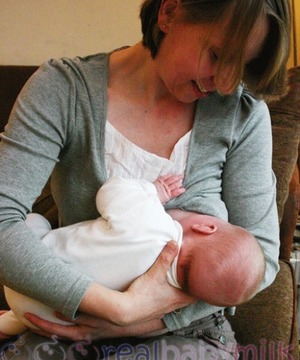
When you are sure that the baby is attached and suckling well, you can bring that hand and arm around the baby too.
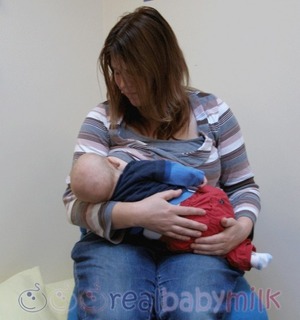
The position most mums use instinctively
Your hand needs to be supporting your baby’s shoulders and he is free to tilt his head back out over your wrist. Baby’s head needs to be free to tilt back.
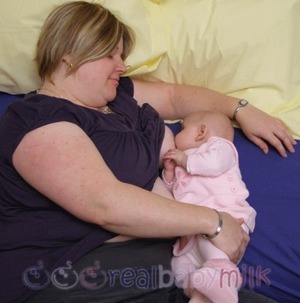
Useful if you have:
- Painful stitches or haemorrhoids
- Had a caesarean section
- Also helpful if you are tired, and need to feed and rest, but make sure it is safe for your baby if you were to fall asleep while feeding.
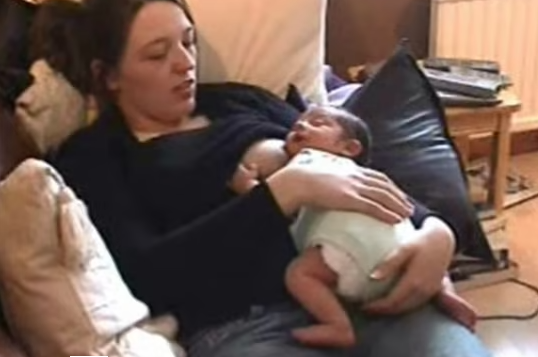
Another way to enable your baby to be able to access the breast is to place baby on your body and allow her to self attach. You need to be reclining so that your baby feels secure. You may need to support baby and/or your breast.
Positioning yourself and your baby in this way can help gently encourage skin to skin and body contact, and to enjoy a special closeness without either feeling any pressure to “get on with” feeding. Instead, this position encourages your baby to use natural reflex behaviour to help them to find your breast and feed effectively when ready.
Please click here for NHS Choices support
Click the video link below to see examples of these positions:
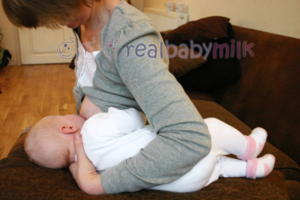
Very helpful if you have:
- A small or pre-term baby
- A caesarean section
- Large breasts or inverted nipples
Breastfeeding offers comfort as well as food, that's why breastfed babies are generally more easily settled.
To help build your confidence:
Breastfeeding in public can mean breastfeeding in front of a relative or friend in your own home, or in a public place, such as a cafe or shopping centre.
During your baby’s early days, you may prefer to breastfeed only where you feel most comfortable. But, as you get more used to doing it, you’re likely to feel more confident about breastfeeding in front of other people when you're out and about.
Here are some ideas to help you get started:
Plan ahead. Before you go out, it can help to think about where you will feel comfortable breastfeeding when your baby gets hungry. Ask breastfeeding friends or your health visitor if they know of a spot, such as a cafe, that they’ve found to be breastfeeding-friendly.
Clothes and bra. What you wear when you’re breastfeeding is a matter of personal taste and what you feel comfortable in. For example, some mums like to wear loose tops that can be lifted up. Others, who prefer to keep their tummy covered, wear two stretchy tops so that the top layer can be lifted up and the bottom layer can be pulled down. A soft non-underwired bra can be easily pulled up or down when you want to feed your baby.
Baby slings, scarves and cloths. Some baby slings are designed in such a way that you can breastfeed while your baby is still in the sling. Ask your health visitor for more information. Some mums feel more comfortable laying a scarf or muslin cloth over their chest while they’re breastfeeding.
Take someone with you. Sometimes, it helps to go with a friend who has an older baby and can take you to places that she already knows would be comfortable for you to sit and feed. Or go with someone else, such as your mum, partner, sister or friend so that there's always someone to talk to.
Avoid the loos. Don’t feel that you should sit in a public toilet to breastfeed. You wouldn’t eat in there, so don’t feel that your baby should.
Know your rights. You shouldn’t ever be made to feel uncomfortable about breastfeeding in public. In fact, the Equality Act 2010 has made it illegal for anyone to ask a breastfeeding woman to leave a public place such as a cafe, shop or public transport.
Breastfeeding is convenient when you are out and about with your baby. You can shop and meet friends with your breastfeeding baby. There is very little to organise for trips, just bring a nappy change.
Since breastfeeding often looks like just cuddling a baby most people don't notice it. Wearing a top that lifts to let your baby feed will help you to feed discretely. Some mothers like to drape a scarf over their shoulder while feeding.
You are entitled to breastfeed in public places and you don't have to ask. Some places may offer a private area if you would like this, but you do not have to use it.
Your baby can look for food or comfort anywhere and at anytime. Feel free to offer your baby a breastfeed whenever and wherever he or she needs it.
Occasionally, there are medical reasons for not breastfeeding e.g. if you have HIV or, sometimes if you're taking certain types of medication that may harm your baby. Under these circumstances when there's no alternative, bottle feeding with infant formula will be recommended. If you're not sure whether you should breastfeed your baby, speak to your midwife or health visitor for information and support.
New mums often talk about the benefits of breastfeeding for them and their babies, and they can give tips on what to do if you have trouble breastfeeding. Sometimes it can be hard to ask for help, but tackling breastfeeding problems quickly will give you more time to enjoy your baby's early days. In many cases, the solution is as simple as changing your baby's position or feeding them more often.
If your baby is unsettled at the breast and doesn't seem satisfied by feeds, it may be that they're not attached to the breast correctly. Go to Breastfeeding: positioning and attachment to check that your baby is feeding well. lt can also be helpful to ask a breastfeeding supporter to work with you to improve positioning and attachment of your baby.
If your nipples hurt, take your baby off the breast and start again. To do this you can slide a finger gently into the corner of the baby's mouth until their tongue releases. Putting up with the pain could make things worse. If the pain continues or your nipples start to crack or bleed, ask a breastfeeding supporter to help you get your baby attached effectively. Pain is not normal, so ask for help and support.
The following ideas may help:
An over-supply of milk can build up in your breasts for a variety of reasons. If your baby is not well attached it may be hard for them to take your milk effectively, and some parts of your breast may not be drained during a feed. This is the area of your breast that may feel sore or painful. It is worth checking to see if this is a possible cause so that you can prevent it from happening again. If you're not sure, ask for help. Other common causes include wearing a bra that's too tight, a knock or blow to the breast, and missing a feed.
It's important to deal with a sore breast or a blocked duct as soon as possible so that it doesn't lead to mastitis (inflammation of the breast).
If you have mastitis you're likely to have at least two of the following symptoms:
This can happen very suddenly and can get worse very quickly. It's important to carry on breastfeeding as this helps to speed up your recovery. If you think you might have a blocked duct or mastitis, try the following:
Mastitis may also be a sign of infection. If there's no improvement within 12 to 24 hours, or you start to feel worse, contact your GP or healthcare professional. If necessary, they can prescribe antibiotics that can be taken while breastfeeding.
Stopping breastfeeding will make your symptoms worse, so ask for help and support early.
Click for additional information, also see attached leaflet!
If you suddenly get sore, pink nipples after you've been feeding without problems for a while, you may have an infection known as thrush. Ask your health visitor or another breastfeeding supporter to check that your baby is attached effectively. Alternatively, you could make an appointment with your GP.
You and your baby will both need treatment. You can easily give thrush to each other, so if your baby has it in their mouth you will still need some cream for your nipples or an oral thrush tablet to stop it spreading to you. You many want to ask your pharmacist for information. Some anti-fungal creams can be bought over-the-counter from a pharmacy as well. If in doubt, seek further information and help from your health visitor or GP if either you or your baby continue to have symptoms.
See link here for more information!
Some babies are born with a tight piece of skin between the underside of their tongue and the floor of their mouth which is known as tongue-tie and it can affect feeding by making it hard for your baby to attach effectively at your breast. Tongue-tie is easily treated so if you have any concerns, talk to your midwife, health visitor or GP.
The Baby Friendly Initiative provide a list of locations where tongue-tie can be divided.
Many myths and stories about breastfeeding have been passed down through family and friends, but some are inaccurate or out-of-date. See how many you've heard, and separate fact from fiction:
Fact: 78% of women in England start breastfeeding.
Fact: Breastfeeding doesn't cause your breasts to sag, but the ageing process and losing or putting on weight can all have an effect.
Fact: Infant formula isn't the same as breast milk. It's not a living product so it doesn't have the antibodies, living cells, enzymes or hormones that protect your baby from infections and diseases later in life.
Fact: Surveys actually show that the majority of people don't mind women breastfeeding in public at all. It's perfectly natural and normal.
Fact: Almost all women are physically able to breastfeed. It's a skill that every woman needs to learn and practise before it becomes easy. It happens more quickly for some women than others, but nearly all women can produce the amount of milk their baby needs.
Fact: After you've had your baby you'll decide when it's time to have sex with your partner. The same hormone that helps to release your milk for the baby (oxytocin) is also made when you have sex so you may leak a little breast milk which is completely normal.
All babies are different, and it may depend on the type of birth you've had. Your baby should feed within the first hour after birth to get off to a good start. Babies then sometimes have a sleep and will start to give you signs that they're ready for the next feed such as:
If your baby doesn't have a feed in the first hour, try skin-to-skin contact, putting them to your breast as soon as possible so that they're not left without a feed in the first six hours.
A newborn baby's stomach is only the size of a walnut, therefore they will need to feed 'little and often'. This is why baby-led feeding, or 'on-demand feeding' is so important. Your baby can have a good feed and be hungry again quite quickly. Babies go through patterns of feeding more and less as they grow. Letting them feed when they need to will ensure that they're content and getting the milk they need, when they need it.
Every baby is different. Some babies want frequent short feeds, and others prefer feeding for longer. Let your baby finish the first breast, then offer the second. If your baby feeds all the time and you're worried, call the National Breastfeeding Helpline on 0300 100 0212 to discuss help with positioning and attachment.
Twins, triplets and other multiples can be breastfed. Because multiple babies are more likely to be born prematurely and have a low birth weight, breast milk is especially important for their wellbeing. When you start breastfeeding you may find it easier to feed each of your babies separately until feeding is well established and you feel confident about handling them at the same time which may take a few weeks.
It can be really helpful to talk to other mothers who have breastfed twins, either at an antenatal session or meeting at a twins group in your area. Triplets can be breastfed either two together and then one after, or all three rotated at each feed. Read more about Feeding twins and multiples.
Yes, you can. Make sure you get a skin-to-skin cuddle with your baby as soon as you're able to. Your midwife may help you have a skin-to-skin cuddle in theatre, or in the recovery room. If you keep your baby close to you and maintain lots of skin-to-skin contact, you'll be able to put them to the breast often, and this will stimulate your milk supply.
After a caesarean you might find that the 'rugby hold' [baby's body is around to the side of your body supported by the arm on the same side] is preferable to having the baby lying on your stomach. Ask your midwife for pain relief before you're likely to feed your baby so that you can feed comfortably.
If you have a planned caesarean, talk to your midwife about expressing some breast milk before you have the baby. This can be available for use afterwards if necessary, either by cup or by syringe.
Exclusive breastfeeding (with no other food or drink) is recommended for around the first six months of a baby's life. After this, breastfeed alongside other foods for as long as you and your baby wish. This might be into their second year or beyond. Find information about introducing your baby to solid foods.
Every day you breastfeed makes a difference to you and your baby. There's no need to decide at the beginning how long you'll breastfeed for. Many mothers continue to breastfeed when they return to work or college. Read about breastfeeding after returning to work.
All mums want to know that their baby is feeding well. When you first start breastfeeding, you may wonder if your baby is getting enough milk. There are clear signs that you can look out for.
Signs that your baby is feeding well:
Signs that your baby is getting enough milk: